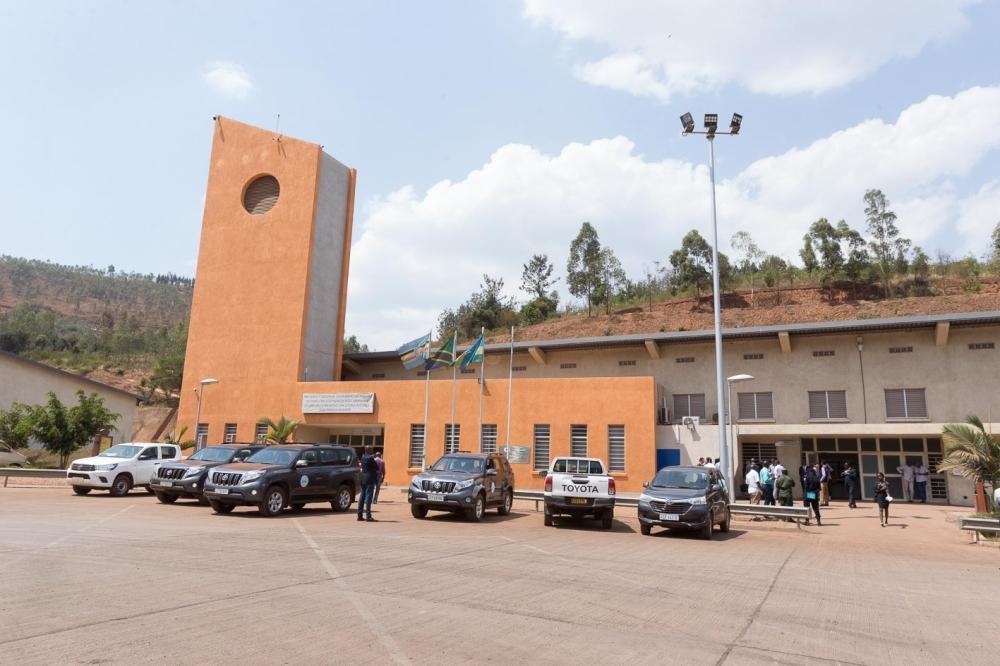Africa-Press – Rwanda. Noel Nkurikiye, a cross-border truck driver and the secretary general of Rwanda Professional Truck Drivers Union, recalls how a small bridge crossing AKagera River between Rwanda and Tanzania used to cause delays and inconveniences. The bridge, known as Rusumo International Bridge, was a bottleneck.
“Since it was not possible for two trucks to cross the bridge simultaneously, one truck had to wait for the other to pass. A large number of trucks use the bridge, and such waiting took a long time, affecting the timely arrival of goods due to the congestion,” he explained.
Nkurikiye says that currently, trucks from both sides can use the bridge at the same time, speeding up movement after its expansion, funded by the Japan International Cooperation Agency (JICA).
The Rusumo International Bridge is now a two-lane road bridge, replacing the older single-lane structure.
A view of Rusumo Bridge that connects Rwanda and Tanzania at Rusumo One Stop Border Post in Kirehe District.
It measures approximately 80 metres in length and about 13.5 metres in width. Its load capacity has increased to 180 tonnes—more than triple the previous limit of around 53 tonnes. The speed limit has risen from 5 km/h to 30 km/h, greatly enhancing transportation efficiency.
By increasing capacity and reducing bottlenecks, the bridge facilitates commerce and transport. It lies on the Central Corridor, serving as a key logistics link for the countries of East Africa.
For many years, the bridge suffered from constant congestion due to structural deterioration and complex customs procedures.
“Before the bridge and One Stop Border Post facility improvements , we were delayed by around one hour. Now, that time has been saved, enabling more efficient cross-border trade and movement,” Nkurikiye said.
JICA, which has played a pivotal role in enhancing Rwanda’s regional integration through strategic infrastructure development, is celebrating 20 years in Rwanda, starting from its reopening in 2005 after closing operations in 1994.
Economic Infrastructure is one of designated pillars which JICA Rwanda supports, under Human Security and Quality Growth.
Rusumo–Kayonza road
JICA also supported the construction of the Rusumo–Kayonza Road. This section is part of the Kagitumba–Kayonza–Rusumo Road, a 208-kilometre national road in Rwanda’s Eastern Province, running from Kagitumba at the border with Uganda, through Kayonza, to Rusumo at the border with Tanzania.
It connects two major regional trade corridors: The Northern Corridor via Uganda (through Kagitumba) and the Central Corridor via Rusumo into Tanzania
Prior to 2018, much of the road was gravel and in poor condition. The upgrade has reduced travel times and transport costs. It included improved design, shoulders, drainage, and street lighting, which led to a reduction in accidents by over 60%.
“Trucks were given a dedicated lane around Kabarondo urban centre to reduce accidents and traffic jams. There used to be many accidents, but now we reach our destinations on time,” Nkurikiye testified.
The road links remote districts and enables smoother access to social services (health, education, markets), cross-border trade, and international routes via borders with Uganda and Tanzania.
It has also boosted local economic activities, land values, and livelihood opportunities (e.g., transport businesses, trade), and improved access for rural communities.
One Stop Border Post (OSBP)
JICA supported the establishment of a One Stop Border Post (OSBP) at the Rwanda–Tanzania border to facilitate more efficient cross-border trade and movement.
These projects ease the movement of goods and people between Rwanda and its neighbours and support the East African Community’s goals for deeper regional integration.
According to Nkurikiye, the absence of an OSBP used to delay services for truck drivers and cross-border traders.
“We used to go to the migration office on the Rwandan side for checking and stamping before crossing to Tanzania. After reaching the Tanzanian side, we had to go to their migration office for another round of checks and stamping.
This was in addition to the congestion caused by the small bridge. Today, we move directly from the migration office on the Rwandan side and no longer face double checks. All checks are done on the Rwandan side, thanks to the OSBP. This has reduced waiting time by one hour. Currently, the maximum waiting time is 30 minutes,” he said.
The OSBP integrates customs, immigration, and other border control services for both countries under one roof, so travelers and cargo no longer need to stop twice.
It enables Rwanda and Tanzania to share and coordinate customs, immigration, and health checks, reducing time and paperwork.
“Both Rwanda and Tanzania’s migration services are delivered in one centre. This has reduced long queues. It now takes me 10 minutes for clearance before continuing to Tanzania to import cereals and beans. Previously, it could take over two hours. We cross the border twice a month and import over 10 tonnes of cereals and beans,” said Jaqueline Ahishakiye, representative of the Duhahirane Rusumo cooperative.
The cooperative started in 2015 as a savings group before becoming a formal cooperative.
“The savings have helped members meet needs such as health insurance and school fees. I have three children. Thanks to the OSBP, I spend less time traveling to Tanzania and return in time to care for them. During the construction of the Kayonza–Rusumo road, we cross-border women were given Rwf5 million as capital to boost our trade,” she noted.
Felicien Mwumvaneza, Commissioner for Customs at the Rwanda Revenue Authority, explained that the OSBP and the implementation of the EAC Single Customs Territory Framework under the Customs Union Protocol have significantly improved customs clearance and trade facilitation.
“The main positive outcomes include reduced clearance time. Cargo truck clearance time has dropped from an average of about four hours to only about 30 minutes. This is due to the joint processing procedure under the OSBP framework, where cross-border formalities are no longer done separately on each side,” he stated.
He added that customs, migration, and other border control agencies from both countries now work collaboratively, sharing information and harmonizing procedures under one roof, allowing faster cross-border clearance.
“The OSBP facilities have helped increase cross-border movement, with more trucks now able to cross. Improved border infrastructure has also enabled 24-hour operations at the Rusumo border post,” he noted.
JICA also assisted with the preparation of operational manuals and technical training for customs officials.
Expert’s view
John Bosco Kalisa, an expert in regional integration and outgoing CEO of the East African Business Council, emphasised that the construction of the Rusumo–Kayonza Road and the Rusumo International Bridge are critical infrastructure that facilitate trade and movement across the Central Corridor.
He noted that these investments enhance Rwanda’s competitiveness in the region by reducing the time and cost of doing business and attracting investment.
“The Central Corridor accounts for almost 80% of Rwanda’s imports and exports. It is a vital artery connecting Rwanda to the rest of the world through the port of Dar es Salaam. Therefore, this is a noble investment for the country and aligns well with the aspirations of the second National Strategy for Transformation, which aims to double the value and volume of exports,” he said.
For More News And Analysis About Rwanda Follow Africa-Press






